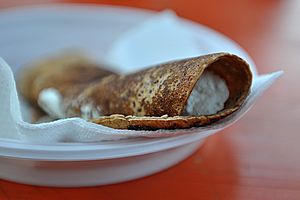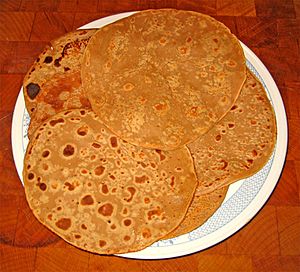Neccio facts for kids
A neccio (say: NET-cho) is a thin, flat pancake or galette made from chestnut flour. It's a special food from the mountain areas of Tuscany and Emilia in Italy, and also from the island of Corsica in France.
Today, most people enjoy necci as a dessert. But long ago, farmers used to eat them with savory foods as a main meal. The Italian government has even officially recognized neccio as a "traditional Italian regional food" from Tuscany!
Where can you find Neccio?
Neccio is a popular food in several places. You can find it in areas like Pescia and the Pistoia Mountains, Lucchesia, upper Versilia, Garfagnana, Frignano, and the upper Reno valley in Italy. It's also made on the French island of Corsica.
Other names for Neccio
In a part of Tuscany called Garfagnana, the word "neccio" can mean both the pancake and the chestnut nut itself, along with things made from chestnuts.
People use different names for neccio depending on where they are:
- Ciaccio is used in Versilia, upper Garfagnana, and Frignano.
- Cian is heard in Lunigiana.
- Caccìn is used in the province of La Spezia.
- Panèlla is the name in Sestri Levante and nearby areas.
- Castagnaccio or patolla are used for a thicker version.
- In Corsica, it's called nicciu.
How to make Neccio
The dough for neccio is quite simple. It's made from chestnut flour, water, and a little salt. In the Pistoia area, chestnut flour is stored in special wooden containers.
Cooking necci needs skill and special tools. People use either round stone discs called testi or iron discs with long handles called ferri or forme. Both are heated over a fire or on a wood stove. Today, testi are more common on the Bologna side of the Apennines, while ferri are used more in the Pistoia mountains.
Cooking with testi is a bit tricky. First, chestnut leaves are gathered and soaked in warm water. These leaves stop the necci from sticking to the testo and give them a special flavor. After the testi are hot, a few leaves are placed on one testo. Then, a scoop of dough is added, followed by more leaves and another hot testo. This creates a stack called a "castellina." An iron holder keeps the stack steady. Usually, people make stacks of 10 to 20 necci. After about two to three minutes, the necci are ready!
Stuffed Neccio

After cooking, necci are often filled and rolled up like a cannolo. They are usually stuffed with ricotta cheese. Sometimes, people add dark chocolate chips or candied fruit to the ricotta.
Here are some ways neccio can be enjoyed:
- A biuscio: This means "without seasoning" in a local dialect. It's eaten plain.
- Guercio: This means "one-eyed." A thin slice of pancetta (a type of bacon) is added before cooking or as a filling. In the Bologna mountains, they might use slices of Tuscan Rigatino (similar to pancetta).
- Incicciato: This means "with meat." Salsiccia paste is added to the dough or used as a filling. This version is popular in the Pistoia mountains, especially in the village of Pracchia.
- Con nutella: This is a modern, non-traditional way. Neccio is stuffed with lots of chocolate cream. Young people especially love this version!
- Con ricotta: This is a common way, with sheep or cow ricotta cheese. It's often found in the Pistoia Apennines.
- Con stracchino: This version includes stracchino cheese and is typical of Lunigiana.



